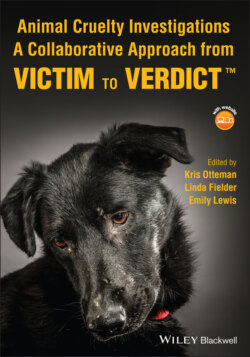Читать книгу Animal Cruelty Investigations - Группа авторов - Страница 177
6.3 How Veterinary Forensics Differs from Traditional Veterinary Medicine
ОглавлениеOwing to the advancement and increasing specialization of veterinary medicine and the recent expansion of the crucial role veterinarians play in the fight against animal cruelty, the field of veterinary forensics has emerged. This specialized area within the profession is gaining tremendous recognition, while establishing knowledge and practices that benefit humans and animals in communities around the world.
Figure 6.2 The forensic veterinarian’s role includes examining physical evidence and reporting on its significance.
Source: Oregon Humane Society.
Forensics is defined as gathering evidence to evaluate whether a crime has occurred [3]. The veterinary exam, which is well defined by academic training and practice, becomes a forensic exam when the information gathered is used in this manner. Thus, any veterinary exam could be used as evidence in a legal matter. Medical records and opinions of veterinarians are scrutinized by colleagues, clients, and others as a matter of normal business. The significant difference in a forensic exam is that the information included may involve additional detail and organization of information such as housing, behavioral observations, extensive medical history, and husbandry. Ancillary reports, photos, physical evidence, witness statements, investigators notes, and other items not traditionally reviewed in clinical practice may also become part of the forensic examination report (Figure 6.2). The field of veterinary forensics also varies from other specialties in that it is not commonly a full‐time focus in everyday veterinary practice, but rather a skill that all practitioners may need to draw on as part of their clinical and community duties when the need arises or when they are called upon.
